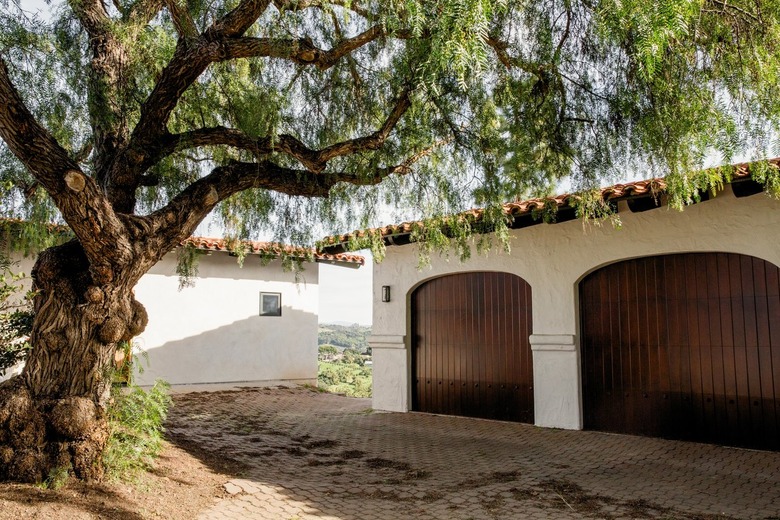How Do You Seismic Retrofit Your House?
Older homes are much more likely to remain standing after a big earthquake hits if homeowners have put energy into a seismic retrofit, but that doesn't mean their homes won't sustain damage. The purpose of retrofitting your house isn't to prevent damage altogether — because that's almost impossible — but rather to minimize structural damage, prevent fires, make cleanup easier and get you back into your home sooner. That last benefit is an important one if the quake happens during a period of cold and wet weather, and your only other option is to hunker down in a Federal Emergency Management Agency shelter.
If you've ever experienced an earthquake, like the one that struck the San Francisco Bay Area in 1989, from the relative safety of a beach, you'll have a pretty good idea of how buildings get damaged. During an earthquake, the ground behaves almost like a bowl of Jell-O, undulating horizontally and vertically at the same time. Buildings don't have the freedom of movement that sand or soil have, so when the undulations are severe, the structure separates from the foundation, and that's when most of the damage occurs. Two of the main goals of a seismic retrofit, then, are to tether the building to the foundation and reinforce the cripple walls that support the structure.
No matter how solidly the foundation is secured, however, the building is still going to move, breaking gas and plumbing lines and damaging parts of your HVAC and electrical systems. Some of this damage is unavoidable, but it can be minimized by undertaking the appropriate earthquake retrofitting, which typically costs between $3,000 and $7,000 or more depending on your home's topographical situation. That isn't cheap, but it's a drop in the bucket compared to the costs of cleaning up a home that hasn't had a seismic retrofit.
Tip
The basic purpose of a seismic retrofit is to secure a building to the foundation, reinforce the cripple walls and otherwise make the building able to withstand the shaking of an earthquake. A complete retrofit also includes securing items inside the house.
Assessing the Need for a Seismic Retrofit
Assessing the Need for a Seismic Retrofit
In North America, West Coast states and provinces are the most likely to experience earthquakes, but seismic events have been known to occur in areas without the network of fault lines that crisscross the West Coast. In fact, 42 states experienced at least one strong earthquake in the period between 1974 and 2003, and 32 states experienced six or more.
As you might expect, the leaders are the seismically active states of Hawaii, with 1,533, California, with 4,895, and Alaska, with 12,053 events. It stands to reason that homeowners in these states have more to gain from a seismic retrofit than those in Pennsylvania or New Hampshire, which each recorded only six strong earthquakes during that period.
Seismic retrofitting isn't always worth it, even if you live in California or Alaska. Because the main purpose of the procedure is to prevent your house from falling off the foundation, you get the benefits only if the foundation is in good enough shape to itself survive the quake. Foundations can be damaged by poor drainage, shifting soil or just age, and a foundation in distress usually produces telltale symptoms, such as:
- Splits and cracks in the concrete
- Out-of-level floors
- Sticking doors and windows
- Cracked walls
- Gaps around doors or windows
If you notice any of these signs, your best bet is to have the foundation inspected by a structural engineer before you consider seismic retrofitting. You may be able to have the foundation repaired at a cost you can afford, but if not, it's probably better to take your chances that a quake won't happen in your area than it is to spend money to bolt your house to a foundation that is likely to crumble in a strong seismic event.
A Seismic Retrofit Starts With Foundation Bolting
A Seismic Retrofit Starts With Foundation Bolting
On a building constructed on a concrete perimeter foundation or slab, bolting secures the building's sill plate (mudsill) to the foundation and prevents the structure from sliding sideways when the shaking starts. The building code in California and other earthquake zones requires seismic anchor bolts and washers on all new construction, but older buildings may have too few bolts to meet current code or may be lacking them altogether.
Contractors use either expansion bolts — which can be driven deep into the concrete — when the concrete foundation is strong enough to resist cracking, but on older homes, they typically use epoxy-set bolts that don't have to be driven as deep. Depending on local regulations, some contractors may use strong steel foundation plates instead of bolts, screwing one end to the mudsill and bolting the other end to the foundation. Some drywall removal may be necessary to access the sill plate.
Homes built on post-and-pier foundations are more vulnerable to shifting, and a retrofit strategy is more expensive, costing anywhere from $10,000 to $15,000. It usually includes pouring a new concrete footing around the perimeter and constructing a new cripple wall to support the structure.
Brace the Cripple Walls
Brace the Cripple Walls
Cripple walls are the short walls built on top of the foundation that extend to the first floor to support the structure and form the crawl space, and they are the walls most subject to shear forces during an earthquake. During an earthquake retrofit, cripple walls are braced with double studs, bolted to the foundation, secured to the floor joists or the rim joist with special connectors and covered with S-1 sheathing plywood with air vent holes. This turns them into shear walls capable of resisting the sideways shifting caused by an earthquake.
Reinforce Garage Doors
Reinforce Garage Doors
An unreinforced garage door represents a large, open space that strong earthquake forces can easily deform, and often, above the garage is a bedroom or playroom that is especially vulnerable to damage because of the lack of shear resistance in the wall structure below. This is called a "soft story" because it's soft in its resistance to lateral movement. The situation can often be remedied by reinforcing the walls on either side of the garage door with plywood sheathing, but sometimes, the garage door frame has to be replaced with steel framing.
Make Chimneys Earthquake-Ready
Make Chimneys Earthquake-Ready
Some of the busiest contractors in the Bay Area after the 1989 quake were those who worked on chimneys because very few if any brick chimneys survived intact. In Los Angeles during the 1995 Northridge quake, some 15,000 chimneys suffered damage. If your home has a brick chimney, there's a good chance it will be damaged no matter what you do, so you should protect the roof by adding a layer of plywood sheathing.
It will also help to replace the upper part of the chimney, which is the part that shakes and twists the most, with steel and add diagonal steel braces to the chimney. If you don't use the chimney, the best way to make sure it doesn't fall over is to insert a metal tube that extends the length of the chimney and then fill the tube with concrete.
Install an Automatic Gas Shutoff Valve
Install an Automatic Gas Shutoff Valve
In the aftermath of the 1995 earthquake in Kobe, Japan, fires caused by broken gas connections did more damage and caused more loss of life than the earthquake itself. An important part of an earthquake retrofit is to install an automatic gas shutoff valve on the incoming gas supply line just after the main shutoff valve. A magnetized metal ball inside the valve housing gets displaced when the shaking starts and closes the valve to prevent gas from escaping from ruptured pipes. This is a job that should be done by a licensed gas fitter or by a representative of the gas company.
If your house has a propane tank out in the yard, it should be anchored to a concrete pad and have an automatic shutoff installed at the point where the supply pipe is attached. It's also important to clear the area around the tank, taking particular care to remove any flammable liquids, such as gas or diesel fuel.
Secure the Water Heater
Secure the Water Heater
When water heaters fall over during an earthquake, they break their gas, water and electrical connections, causing flooding as well as possibly charging the water with electricity or releasing gas. To prevent this, part of the retrofit work is to strap the water heater to a sturdy wall with at least two metal straps. This is a DIY project. Straps are available at building supply centers, and all you have to do is follow the supplied instructions. If the only wall available is covered with drywall, make sure to secure the straps to studs, not just to the drywall itself.
Indoor Seismic Retrofit Is Mostly DIY
Indoor Seismic Retrofit Is Mostly DIY
If you get caught indoors during an earthquake and you haven't done any preparation, you're in danger whether or not you've completed a structural retrofit. The kitchen is particularly hazardous because as the house shakes, pretty much everything in the cupboards and on the shelves is headed for the floor. Some of these objects are heavy, and many are breakable, so even if you don't get bonked on the head, you'll probably find yourself wading through a sea of glass shards.
You can take several preventative measures to minimize earthquake damage in the kitchen, and most of them are things you can do yourself:
- Cover shelves with nonslip shelf liners to prevent glass and metal items from shimmying off the shelf and falling to the floor when the house shakes.
- Put heavy items on lower shelves, such as cast-iron frying pans, rice cookers and other appliances. If you have an appliance that lives on the kitchen countertop, such as a microwave or coffeemaker, put a nonslip pad underneath it or find a way to secure it to the wall. It's also a good idea to install raised edges on the front of shelves.
- Install earthquake latches on the cabinet doors. These lock automatically when an earthquake happens, preventing the doors from opening and keeping everything safely in the cupboards. They do not engage during normal activity, even when you slam the doors.
- Secure your freestanding refrigerator to the wall with a specialty fastening kit so it doesn't tip when all the contents suddenly shift.
In the rest of the house, increase earthquake resistance by preventing objects from falling, glass from shattering and furniture from moving around:
- Anchor tall shelving units and cabinets to the wall using corner brackets or some other means.
- Prevent objects from sliding off shelves by putting nonslip liners underneath them or securing them with museum putty, also known as earthquake putty.
- Cover window glass with safety film to guarantee that if the glass shatters, it won't fall all over the floor.
- Make sure the electrical boxes supporting pendant lights, chandeliers and other hanging fixtures are safely secured to a ceiling joist and not just to the drywall.
- Lock the wheels of chairs, sofas and any other large pieces of furniture on rollers.
References
- California Earthquake Authority: Benefits of Seismic Upgrades: Is Earthquake Retrofitting Worth It in CA?
- Statista: Number of Strong Earthquakes In the U.S. from 1974 to 2003, by State
- California Residential Mitigation Program: Post & Pier House Retrofit
- Military.com: Tips To Make Your Home Earthquake Ready
- Temblor: Seismic Retrofit


